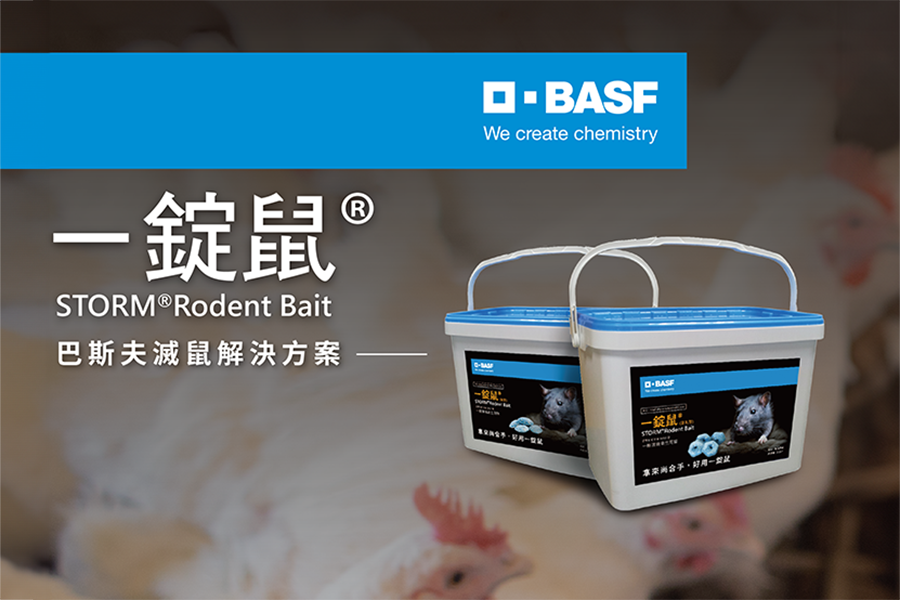
Storm® Rodent Bait is the newest anticoagulant rodenticide on the market. Its mechanism is to disrupt the normal vitamin K cycle, preventing cells from obtaining the energy needed for blood clotting, leading to internal or subcutaneous bleeding and death. Compared to earlier developed rodenticides, it combines features such as rapid action, lethality from a single feeding, high safety, and no resistance development. It is the optimal rodent control solution for farms.
| Manufacturer |
BASF
|
| Origin |
United Kingdom
|
| Ingredient |
伏滅鼠0.005%
|
| How to use |
Survey the rodent situation, set up bait stations, and place bait. Apply 10-15 tablets at each point.
|
| Package |
3 kg per bucket
|
I am interested in this product.
Please contact me.
Watch video to learn more
Usage
- Assess Rodent Observe locations of rat holes and feeding areas. Determine hiding spots and activity routes by examining droppings and gnaw marks.
- Set Up Bait Stations — Place bait stations along rat activity paths or frequented areas such as near rat hole entrances, wall/door openings, and water pipe entrances.
- Baiting —Adjust flexibly based on rat size and population density. General recommendations are as follows:
Dosage form |
Environment of use |
Target pests and dosage |
|
STORM® Rodent Bait (Tablet form) |
Outdoor rodent burrows/ditches |
Apply 40-60 grams (approximately 10-15 tablets) per burrow/point. |
|
STORM® Rodent Bait (Perforated type) |
Indoor and surrounding environment |
To control small rodents (such as roof rats), it is recommended to place a bait station every 1-2 meters, with 20 grams (approximately 1 block) per station. |
|
To control large rodents (such as Norway rats), it is recommended to place a bait station every 5-10 meters, with 40-60 grams (approximately 2 to 3 blocks) per station. |
Dosage form |
Usage |
STORM® Rodent Bait(Tablet form) |
|
|
Outdoor rodent burrows/ditches |
|
|
▶ Apply 40-60 grams (approximately 10-15 tablets) per burrow/point. |
|
STORM® Rodent Bait(Perforated type) |
|
|
Indoor and surrounding environment |
|
|
To control small rodents (such as roof rats) ▶ It is recommended to place a bait station every 1-2 meters, with 20 grams (approximately 1 block) per station. |
|
|
To control large rodents (such as Norway rats) ▶ It is recommended to place a bait station every 5-10 meters, with 40-60 grams (approximately 2 to 3 blocks) per station." |
|
|
Human resource cost |
Replace bait blocks |
Result |
|
STORM® Rodent Bait (Single feeding) |
Reduce costs |
Every 7-10 days |
▶ Address rodent pest issues ▶ Reduce the risk of health and property damage ▶ Reduce costs and increase profits |
|
Other rodent baits (Multiple feedings of rodent bait) |
High cost |
Every 3-4 days |
▶ Postpone rodent pest control timing ▶ Long-term hazards leading to multiple management issues ▶ Costs more and causes more damage |
|
|
Human resource cost |
Replace bait blocks |
|
STORM® Rodent Bait (Single feeding) |
Cost-saving |
Every 7-10 days |
|
▶ Address rodent pest issues ▶ Reduce the risk of health and property damage ▶ Reduce costs and increase profits |
||
|
Other rodent baits (Multiple feedings of rodent bait) |
High cost |
Every 3-4 days |
|
▶ Postpone rodent pest control timing ▶ Long-term hazards leading to multiple management issues ▶ Costs more and causes more damage |
||
Rodent Damage
- Theft and Contamination — Crop losses in fields, damage to stored grains, livestock feed, and food factory contamination. Additional losses due to contact contamination are about 3-5 times the amount of theft.
- Disease Transmission — Rats are hosts to various pathogens. Many infectious diseases spread through rats or their excrement, such as rat-bite fever, plague, murine typhus, and hantavirus.
- Facility Damage — Rats have continuously growing hard incisors that need constant gnawing, often damaging electrical wires, water pipes, and other facilities, causing disasters and inconvenience.
- Livestock Disturbance — Rats disturb, and may even bite to death or injure poultry and young livestock, causing losses and indirectly affecting production when startled.
Rat Habits
- Omnivorous — Rats will consume crops, feed, food, and anything edible. Different species have different preferences.
- Large Activity Range — Rats can swim, dive, climb, and burrow through walls. They are typically nocturnal, with a maximum activity range of up to 150 meters. Its activity is more frequent in spring and autumn compared to summer and winter, making these important prevention seasons.
- Cautious and Suspicious — Rats have memory capability for objects and environments that caused negative experiences, making common physical prevention methods (such as traps or glue boards) easily ineffective. They may also develop aversion to highly toxic or poorly formulated baits.
- Food Hoarding — Rats used to drag food to burrows or other hidden locations. Dragging rodenticides can risk contamination and accidental ingestion by other animals. Using bait stations can help prevent this.
- High Fertility — Early sexual maturity, short gestation, multiple offspring per litter, and year-round breeding capability for rats. Theoretically, a rat can produce over a thousand offspring in a year, leading to extremely rapid population expansion.